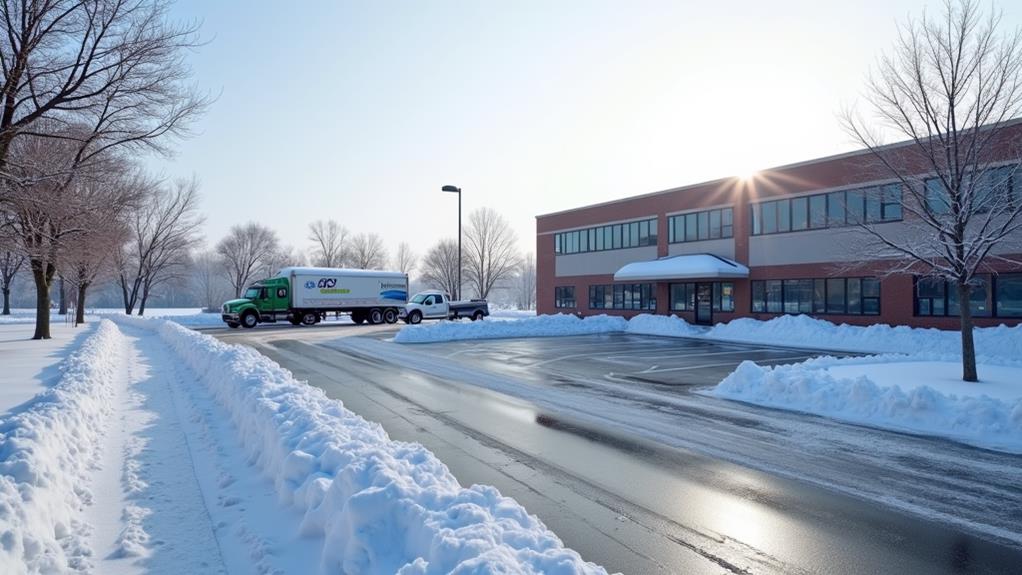
Table Of Contents
Best Practices for Parking Lot Snow Removal
Effective snow removal from parking lots requires a well-orchestrated plan that accommodates the specific layout and usage patterns of the area. Regular maintenance checks before and after snow events can make a significant difference. Staff should be trained in identifying potential hazards, ensuring clear pathways, and managing snow accumulation in high-traffic zones. Employing snow removal equipment that is appropriate for the size of the parking lot helps streamline the process.
Timing is crucial when it comes to snow removal from parking lots. Clear snow as early as possible after a snowfall to prevent hard-pack ice from forming. This proactive approach reduces the risk of accidents and ensures a safer environment for pedestrians and vehicles. Consider the use of plows, salt spreaders, and blowers to expedite the removal process. Communication with property owners or managers can also facilitate timely decisions and enhance overall efficiency.
Creating an Effective Snow Removal Plan
An effective snow removal plan is essential for maintaining safe and accessible parking lots during winter months. The plan should include a detailed schedule outlining when snow removal will take place, taking into account weather forecasts and anticipated snowfall amounts. Clear communication with the snow removal team is crucial to ensure timely responses. Staffing requirements should also be addressed, allowing for enough personnel and equipment to efficiently clear the area. Regular assessments of the plan's effectiveness can lead to necessary adjustments, ensuring a consistent approach to snow management.
When developing a snow removal strategy, it is important to consider specific factors unique to each parking lot. The layout, size, and surface material affect snow removal methods. Snow Removal from Parking Lots should be tailored to minimize disruption to traffic and pedestrians. Incorporation of designated snow storage areas can prevent accumulation in parking spots. Additionally, ensuring proper drainage can limit water pooling and freezing issues after a snow melt. These steps contribute to a comprehensive plan that facilitates swift and effective snow management.
Snow Melting Systems
Snow melting systems represent a modern solution to the challenges of snow removal from parking lots. These systems utilize heated elements installed beneath the pavement to prevent snow accumulation. By maintaining the surface temperature above freezing, they effectively eliminate the need for traditional snow plowing and shoveling. This technology is becoming increasingly popular in both commercial and residential applications, offering a proactive approach to managing winter weather.
The advantages of heated pavement are significant. Not only do they reduce labor costs associated with manual snow removal, but they also minimize the environmental impact of salt and chemicals typically used for de-icing. Snow melting systems can contribute to safer conditions for pedestrians and vehicles alike by ensuring clear access to parking areas. With investments in this technology, property owners can enhance accessibility without the typical disruptions during winter storms.
Advantages of Heated Pavement
Heated pavement systems offer a modern solution to the challenges of snow removal from parking lots. These systems utilize electric or hydronic heating elements embedded in the pavement, which come to life during winter weather events. This controlled heating effectively melts snow and ice before they can accumulate, reducing the need for manual snow removal techniques. With this technology, parking lot owners enjoy safer driving conditions and reduced liability issues associated with slippery surfaces.
Another notable advantage of heated pavement is the reduction in the use of chemical de-icers. Traditional de-icing methods can lead to environmental concerns, affecting soil and water quality. By relying on heated pavement, parking lot managers can minimize the associated chemical footprint when it comes to snow removal from parking lots. This approach not only benefits the environment but also maintains the integrity of the pavement, prolonging its lifespan while ensuring safety for both vehicles and pedestrians.
Environmental Considerations in Snow Removal
Environmental considerations play a crucial role in snow removal from parking lots. Traditional methods often involve chemicals that can harm local ecosystems. Choosing de-icing materials with lower environmental impacts can safeguard nearby plants and wildlife. Additionally, the disposal of snow can create challenges, as it may contain pollutants that could contaminate soil and waterways if not managed properly.
Sustainable practices are becoming increasingly important in the snow removal industry. These practices encourage the use of eco-friendly products for traction and melting, particularly in urban areas. Implementing snow management plans that prioritize recycling and proper disposal methods can significantly reduce the negative effects of snow removal from parking lots. Adopting these strategies not only protects the environment but also enhances community well-being.
Sustainable Practices for Deicing and Disposal
Sustainable practices in snow removal from parking lots focus on effective de-icing techniques that minimize environmental impact. Traditional salt-based de-icers can lead to soil and water contamination, harming local ecosystems. Alternative substances, such as beet juice or cheese brine, can serve as eco-friendly options that reduce chemical runoff. These organic materials not only help to melt snow but also maintain lower temperatures in the soil, preventing freeze-thaw cycles that can damage pavement and surrounding vegetation.
When it comes to snow disposal, careful planning plays a critical role in preserving surrounding environments. Leaving snow piles in designated areas can prevent damage to landscaping and prevent contaminants from leaching into stormwater. Incorporating methods like snow melting systems in conjunction with sustainable de-icing practices can significantly enhance efficiency. By integrating these strategies, businesses can ensure responsible snow removal from parking lots while also promoting a healthier ecological balance.
FAQS
What are the best practices for parking lot snow removal?
Best practices for parking lot snow removal include creating an effective snow removal plan, using proper equipment, and ensuring timely and efficient removal to minimize hazards and maintain accessibility.
How can I create an effective snow removal plan for my parking lot?
To create an effective snow removal plan, assess the layout and traffic patterns of your parking lot, prioritize areas that require immediate attention, and schedule regular maintenance to adapt to changing weather conditions.
What are snow melting systems, and how do they work?
Snow melting systems are innovative solutions that use heating elements installed beneath the pavement to melt snow and ice on contact, allowing for safer and cleaner parking lot surfaces during winter weather.
What are the advantages of heated pavement for snow removal?
The advantages of heated pavement include reduced labor costs, enhanced safety for pedestrians and vehicles, and decreased reliance on chemical de-icers, contributing to a cleaner and more eco-friendly environment.
What environmental considerations should I take into account for snow removal?
Key environmental considerations include the type of de-icing agents used, the proper disposal of snow and ice, and implementing sustainable practices that minimize pollution and protect local ecosystems.
